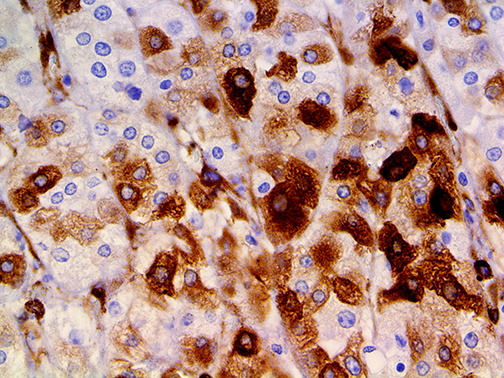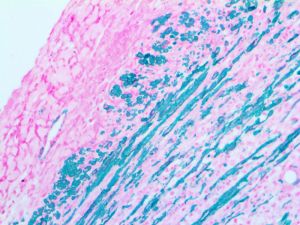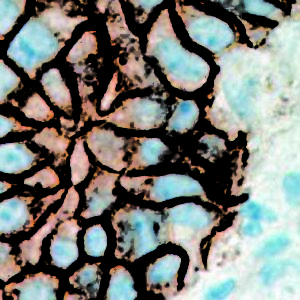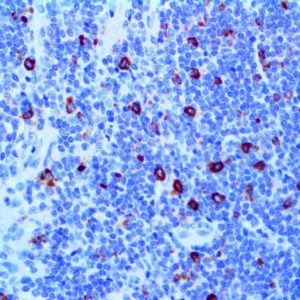
IHC of Osteonectin / SPARC on an FFPE Pancreas Tissue
| Intended Use | For In Vitro Diagnostic Use | |||||||||||||||||||||||||||||||||||
| Summary and Explanation | Osteonectin also known as secreted protein acidic and rich in cysteine (SPARC) or basement-membrane protein 40 (BM-40) is a protein that in humans is encoded by the SPARC gene. Osteonectin is a glycoprotein in the bone that binds calcium. It is secreted by osteoblasts during bone formation, initiating mineralization and promoting mineral crystal formation. Fibroblasts, including periodontal fibroblasts, synthesize Osteonectin. This protein is synthesized by macrophages at sites of wound repair and platelet degranulation, so it may play an important role in wound healing. Osteonectin also increases the production and activity of matrix metalloproteinases, a function important to invading cancer cells within bone. Additional functions of Osteonectin beneficial to tumor cells include angiogenesis, proliferation and migration. Overexpression of Osteonectin is reported in many human cancers such as breast, prostate and colon. A correlation between Osteonectin overexpression and ampullary cancers and chronic pancreatitis has been reported. A study designed to examine the expression and functional role of Osteonectin in primary and metastatic Pancreatic Ductal Adenocarcinoma (PDAC) showed a 31-fold increase in Osteonectin mRNA levels in PDAC and a 16-fold increase in chronic pancreatitis as compared with the normal pancreas (P < 0.01). By immunohistochemistry, faint immunoreactivity was detected in the normal pancreas. In contrast, strong staining of the cancer cells was observed in addition to extensive Osteonectin immunoreactivity in surrounding fibroblasts and in the extracellular matrix. In metastatic tissues, strong immunoreactivity was observed in fibroblasts and in extracellular matrix surrounding metastatic cancer cells, whereas the signal was absent in most tumor cells. In vitro studies showed that osteonectin was able to inhibit cancer cell growth while promoting invasiveness of pancreatic tumor cells. Another study set out to examine both the transcript levels of Osteonectin and the presence of the molecule in breast cancer tissue and to demonstrate if a link existed between the levels of Osteonectin and clinical outcome. Protein levels of Osteonectin were assessed using immunohistochemistry and levels were correlated with nodal status, grade, prognosis and long-term survival (10 years). Transcript levels of Osteonectin were found to be significantly higher in tumor tissue when compared to normal background breast tissue. Node-positive tumors also exhibited higher levels of Osteonectin than node-negative tumors. Over a 6 year follow-up, high levels of Osteonectin was seen to be significantly associated with the overall survival of the patients and it was concluded that Osteonectin plays a crucial role in tumor development in breast cancer and as such has a significant bearing on patient prognosis and long-term survival. | |||||||||||||||||||||||||||||||||||
| Antibody Type | Mouse Monoclonal | Clone | BSB-93 | |||||||||||||||||||||||||||||||||
| Isotype | IgG1 | Reactivity | Paraffin, Frozen | |||||||||||||||||||||||||||||||||
| Localization | Cytoplasmic | Control | Adrenal, Testis, Placenta, TCC, Testicular Cancer, Cervical Cancer | |||||||||||||||||||||||||||||||||
| Presentation | Osteonectin / SPARC is a mouse monoclonal antibody derived from cell culture supernatant that is concentrated, dialyzed, filter sterilized and diluted in buffer pH 7.5, containing BSA and sodium azide as a preservative. | |||||||||||||||||||||||||||||||||||
| Availability |
| |||||||||||||||||||||||||||||||||||
| Note: For concentrated antibodies, please centrifuge prior to use to ensure recovery of all product. | ||||||||||||||||||||||||||||||||||||



